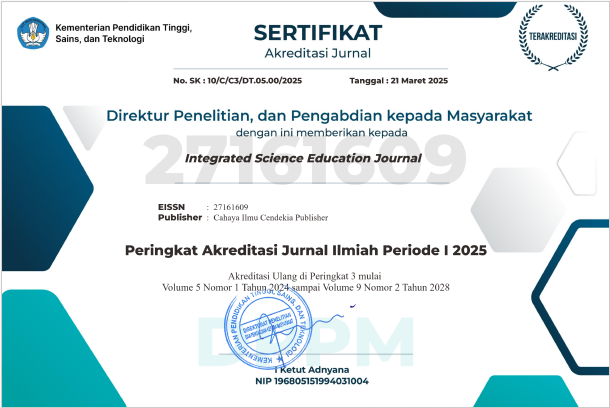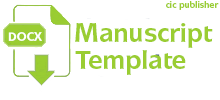Behind the Science literacy of Filipino students at PISA 2018: A Case study in the Philippines’ Educational System
Abstract
Purpose of the study: To find out the struggle to build students' Science literacy experienced by the Philippines in the PISA 2018 results.
Methodology: the methodology used uses Case Study design. The method used by collecting facts from various data, learning curricula, culture and some Science discourse related to science literacy and PISA score. Various facts are analyzed by grouping and classifying and drawing conclusions from the discussion.
decision-makers Findings: integration efforts from teachers, schools, and curriculum continue to be improved by the government to improve the quality of education, although the results of the Science literacy of students in PISA 2018 have not been sufficient.
Applications of this study: This study will provide an open picture to provide innovation, a literature study for the basis of thinking the importance of overall integrase in increasing Science literacy of students, not just teachers
Novelty/Originality of this study: Cultural influences on students' science literacy.
References
[2] OECD, PISA 2018 Assessment and Analytical Framework, PISA. Paris: OECD Publishing, 2019.
[3] N. Baloran, “National Report of the Philippines,” Pasig City, 2019.
[4] OECD, “PISA 2018 Results,” 2019.
[5] R. K. Yin, Case Study Research Design and Methods, 5th ed. Thousand Oaks: SAGE Publisher, 2014.
[6] SEI-DOST & UP NISMED, Framework for Philippines Science Teacher Education. Manila: Science Education Institute, 2011.
[7] A. V. Orleans, “The condition of secondary school physics education in the Philippines: Recent developments and remaining challenges for substantive improvements,” Aust. Educ. Res., vol. 34, no. 1, pp. 33–54, 2007.
[8] V. V Antonio, “Science Laboratory Interest and Preferences of Teacher Education Students: Implications to Science Teaching,” Asia Pacific J. Multidiscip. Res., vol. 6, no. 3, pp. 57–67, 2018.
[9] B. A. Aggabao, N. T. Aggabao, D. F. Antiado, and F. G. Castillo, “Educational Transformation in the Philippine Education System:Towards Global Competitiveness,” Int. J. Bus. Manag. Technol., vol. 2, no. 2, pp. 66–70, 2018.
[10] L. M. Rossana, “Science Literacy: the Effects of Incorporating Literacy Into a High School Environmental Science Classroom,” Monatana State University, 2016.
[11] International Bureau of Education - The Chinse National Commission for UNESCO, “Science Education for Contemporary Society : Problems , Issues and Dilemmas,” in Workshop on the ree teaching of science and technology ate primary and secondary level in Asia: Comparative references to Europe, 2000, no. March, p. 138
[12] Kuswanto, “Where Is The Direction Of Physics Education?” J. Pijar MIPA, Vol. 15 No.1, 59-64, 2020. DOI: 10.29303/ jpm.v15i1.1226
[13] SEI-DOST & UP NISMED, Science Framework for Philippine Basic Education. Manila: Science Education Institute, 2011.
[14] DepEd, “K to 12 Curriculum Guide Science,” Pasig, 2016.
[15] E. B. Macugay and A. B. I. Bernardo, “Science coursework and pedagogical beliefs of science teachers : The case of science teachers in the Philippines,” Sci. Educ. Int., vol. 24, no. 1, pp. 63–77, 2013.
[16] M. T. F. Calderon and D. Ph, “A Critique of K-12 Philippine Education System,” Int. J. Educ. Res., vol. 2, no. 10, pp. 541–550, 2014.
[17] S. B. Gutierez, “Collaborative professional learning through lesson study: Identifying the challenges of inquiry-based teaching,” Issues Educ. Res., vol. 25, no. 2, pp. 118–135, 2015.
[18] D. D. R. Errabo and M. S. Prudente, “Mainstreaming Science Investigation Skills of Grade 7 In-Service Teachers in the Philippines Presented at the DLSU Research Congress 2018,” in DLSU Research Congress 2018; Building Impact on Firm Foundations: From Basic to Applications, 2018, pp. 20–23.
[19] Kuswanto, “Inicial Capability Profile of Science Process Skills of Physics Education’s New Students Academic Year 20016/2017 in Conducting Basic Physics Practicum 1 at Jambi University,” University of Jambi, 2017.
[20] P. J. E. Alegado, “The challenges of teacher leadership in the Philippines as experienced and percieved by teachers,” Int. J. Educ. Res., vol. 6, no. 6, pp. 291–302, 2018.
[21] S. Musa and R. Ziatdinov, “Features and Historical Aspects of the Philippines Educational system,” Eur. J. o Contemp. Educ., vol. 2, no. 2, pp. 155–177, 2012.
[22] L. Read and T. M. Atinc, “Investigations into Using Data to Improve Learning: Philippine Case Study,” 2017.
[23] UNESCO, “Philippines : Education for All 2015 National Review,” Quezon, 2015.
[24] D. S. Maligalig, R. B. Caoli-rodriguez, A. Martinez, and S. Cuevas, “ADB Economics Working Paper Series Education Outcomes in the Philippines,” Mandaluyong, 2011.
[25] NEDA and UNICEF Philippines, Situation Analysis of Children in the Philippines. Quezon: UNICEF Philippines publisher, 2018.
[26] B. F. Nebres, “Building a Science Culture in the Philippines,” in A Progressive Philippines Anchored on Science, 2007, pp. 177–196.
[27] M. A. Sunggod, “Issues- Oriented Approach : Effects on Students ’ Reconstruction and Achievement in Biology,” Int. J. Learn. Teach. Educ. Res., vol. 15, no. 4, pp. 32–41, 2005.
[28] CERI, “21St Century Learning: Research, Innovation and Policy Directions From Recent Oecd Analyses,” Paris, 2008.
[29] L. A. Burton, “Mother Tongue-Based Multilingual Education in the Philippines: Studying Top-Down Policy Implementation from the Bottom Up,” University of Minnesota, 2013.
[30] S. A. Azhary, G. P. Suryadarma, P. I. Devitasari, Kuswanto, “Development of Science E-Flipbook Integrated Illegal Sand Mining on River Basin to Improve Environmental Care Attitude”, International Journal of Education & Curriculum Application, Vol. 3, No. 1, 26-30, 2020, https://doi.org/10.31764/ijeca.v3i1.2036
[31] N. E. Malaluan and D. B. Masangcay, “Physics instruction utilizing culture-based pedagogy,” Asia Pacific J. Multidiscip. Res., vol. 3, no. 4, pp. 50–58, 2015.
[32] L. S. Abad, “An analysis of teachers’ and students’ perceptions of codeswitching in teaching science and mathematics in a Philippine private high school,” J. Asia TEFL, vol. 7, no. 1, pp. 239–264, 2010.
[33] J. Osborne, “Current Trends in Science Education,” 2015.
[34] D. A. McFarlane, “Understanding the Challenges of Science Education in the 21st Century: New Opportunities for Science Literacy,” Int. Lett. Soc. Humanist. Sci., vol. 4, pp. 35–44, 2013.
[35] Nuffic, “The Education System of the Philippines Described and Compated with the Dutch System,” 2019.
[36] D. T. Roy Montebon, “K12 Science Program in the Philippines: Student Perception on its Implementation,” Int. J. Educ. Res., vol. 2, no. 12, pp. 153–164, 2014.
[37] M. Tan, “Nurturing Science and Technological Literacy through Environmental Education.,” J. Int. Coop. Educ., vol. 7, no. 1, pp. 115–131, 2004.
[38] ACTRC, “Large-score assessments for use in the Philippines,” Quezon, 2015.
[39] “Current Status on Science and Technology in ASEAN Countries,” ASHA Lead., vol. 20, no. 9, pp. 22–24, 2015.
[40] A. E. Batomalaque, “Basic science development program of the Philippines for international cooperation.,” 2002.
[41] G. T. Pawilen and M. Sumida, “Using the local language for teaching science in kindergarten in the Philippines,” Asia-Pacific J. Res., vol. 3, no. 1, pp. 101–122, 2009.
[42] OECD, Insights and interpretations, PISA Resul. Paris: OECD Publishing, 2019.
[43] J. R. G. Albert and M. J. Raymundo, “Trends in Out of School Children and other Basic Education Statistics,” Quezon, 2016.
[44] G. T. Pawilen, “Integrating Indigenous Knowladge in the Elementary Science Curriculum,” Harris J. Educ., vol. 1, no. 1, pp. 21–31, 2013.
[45] M. Okabe, “Where does Philippine education go? The ‘K to 12’ program and reform of Philippine basic education,” in IDE Discussion Paper, 2013, vol. 425, no. 425.
[46] M. J. R. Macapagal, Status of Philippine public libraries and librarianship. Quezon: The National Library of the Philippines through the help of National Committee on Libraries and Information Services of the National Commission for Culture and the Arts, 2018.
Copyright (c) 2020 Cahaya Ilmu Cendekia Publisher

This work is licensed under a Creative Commons Attribution-NonCommercial 4.0 International License.
Authors who publish with this journal agree to the following terms:
- Authors retain copyright and acknowledge that the Integrated Science Education Journal is the first publisher licensed under a Creative Commons Attribution 4.0 International License.
- Authors are able to enter into separate, additional contractual arrangements for the non-exclusive distribution of the journal's published version of the work (e.g., post it to an institutional repository or publish it in a book), with an acknowledgment of its initial publication in this journal.
- Authors are permitted and encouraged to post their work online (e.g., in institutional repositories or on their website) prior to and during the submission process, as it can lead to productive exchanges and earlier and greater citation of published work.







.png)
.png)






